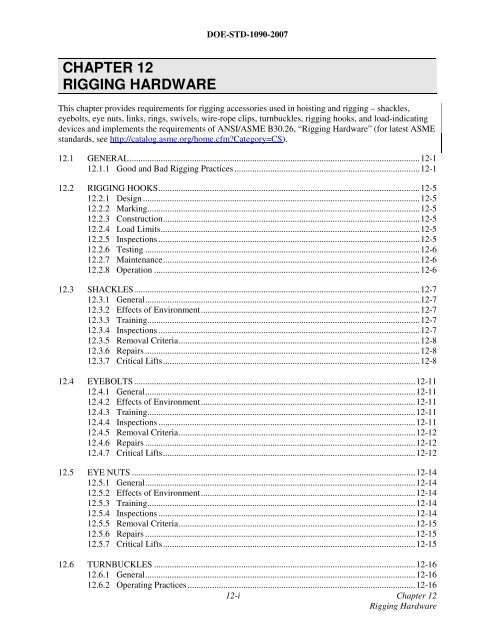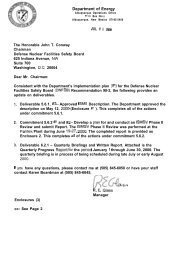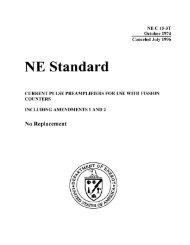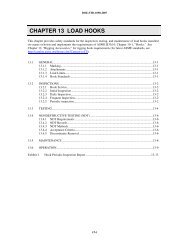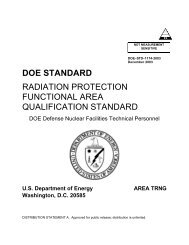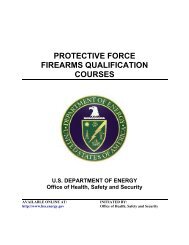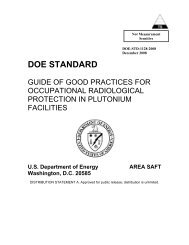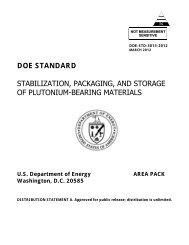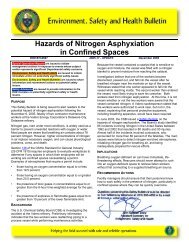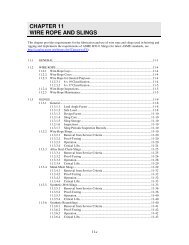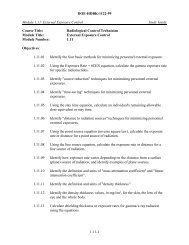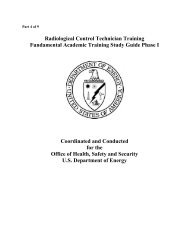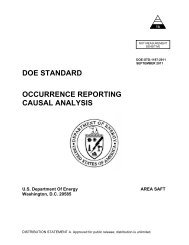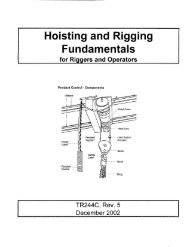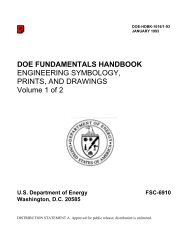Chapter 12 rigging hardware
Chapter 12 rigging hardware
Chapter 12 rigging hardware
You also want an ePaper? Increase the reach of your titles
YUMPU automatically turns print PDFs into web optimized ePapers that Google loves.
CHAPTER <strong>12</strong><br />
RIGGING HARDWARE<br />
DOE-STD-1090-2007<br />
This chapter provides requirements for <strong>rigging</strong> accessories used in hoisting and <strong>rigging</strong> – shackles,<br />
eyebolts, eye nuts, links, rings, swivels, wire-rope clips, turnbuckles, <strong>rigging</strong> hooks, and load-indicating<br />
devices and implements the requirements of ANSI/ASME B30.26, “Rigging Hardware” (for latest ASME<br />
standards, see http://catalog.asme.org/home.cfm?Category=CS).<br />
<strong>12</strong>.1 GENERAL..................................................................................................................................<strong>12</strong>-1<br />
<strong>12</strong>.1.1 Good and Bad Rigging Practices ...................................................................................<strong>12</strong>-1<br />
<strong>12</strong>.2 RIGGING HOOKS.....................................................................................................................<strong>12</strong>-5<br />
<strong>12</strong>.2.1 Design ............................................................................................................................<strong>12</strong>-5<br />
<strong>12</strong>.2.2 Marking..........................................................................................................................<strong>12</strong>-5<br />
<strong>12</strong>.2.3 Construction...................................................................................................................<strong>12</strong>-5<br />
<strong>12</strong>.2.4 Load Limits....................................................................................................................<strong>12</strong>-5<br />
<strong>12</strong>.2.5 Inspections .....................................................................................................................<strong>12</strong>-5<br />
<strong>12</strong>.2.6 Testing ...........................................................................................................................<strong>12</strong>-6<br />
<strong>12</strong>.2.7 Maintenance...................................................................................................................<strong>12</strong>-6<br />
<strong>12</strong>.2.8 Operation .......................................................................................................................<strong>12</strong>-6<br />
<strong>12</strong>.3 SHACKLES................................................................................................................................<strong>12</strong>-7<br />
<strong>12</strong>.3.1 General...........................................................................................................................<strong>12</strong>-7<br />
<strong>12</strong>.3.2 Effects of Environment..................................................................................................<strong>12</strong>-7<br />
<strong>12</strong>.3.3 Training..........................................................................................................................<strong>12</strong>-7<br />
<strong>12</strong>.3.4 Inspections .....................................................................................................................<strong>12</strong>-7<br />
<strong>12</strong>.3.5 Removal Criteria............................................................................................................<strong>12</strong>-8<br />
<strong>12</strong>.3.6 Repairs ...........................................................................................................................<strong>12</strong>-8<br />
<strong>12</strong>.3.7 Critical Lifts...................................................................................................................<strong>12</strong>-8<br />
<strong>12</strong>.4 EYEBOLTS..............................................................................................................................<strong>12</strong>-11<br />
<strong>12</strong>.4.1 General.........................................................................................................................<strong>12</strong>-11<br />
<strong>12</strong>.4.2 Effects of Environment................................................................................................<strong>12</strong>-11<br />
<strong>12</strong>.4.3 Training........................................................................................................................<strong>12</strong>-11<br />
<strong>12</strong>.4.4 Inspections ...................................................................................................................<strong>12</strong>-11<br />
<strong>12</strong>.4.5 Removal Criteria..........................................................................................................<strong>12</strong>-<strong>12</strong><br />
<strong>12</strong>.4.6 Repairs .........................................................................................................................<strong>12</strong>-<strong>12</strong><br />
<strong>12</strong>.4.7 Critical Lifts.................................................................................................................<strong>12</strong>-<strong>12</strong><br />
<strong>12</strong>.5 EYE NUTS ...............................................................................................................................<strong>12</strong>-14<br />
<strong>12</strong>.5.1 General.........................................................................................................................<strong>12</strong>-14<br />
<strong>12</strong>.5.2 Effects of Environment................................................................................................<strong>12</strong>-14<br />
<strong>12</strong>.5.3 Training........................................................................................................................<strong>12</strong>-14<br />
<strong>12</strong>.5.4 Inspections ...................................................................................................................<strong>12</strong>-14<br />
<strong>12</strong>.5.5 Removal Criteria..........................................................................................................<strong>12</strong>-15<br />
<strong>12</strong>.5.6 Repairs .........................................................................................................................<strong>12</strong>-15<br />
<strong>12</strong>.5.7 Critical Lifts.................................................................................................................<strong>12</strong>-15<br />
<strong>12</strong>.6 TURNBUCKLES .....................................................................................................................<strong>12</strong>-16<br />
<strong>12</strong>.6.1 General.........................................................................................................................<strong>12</strong>-16<br />
<strong>12</strong>.6.2 Operating Practices......................................................................................................<strong>12</strong>-16<br />
<strong>12</strong>-i <strong>Chapter</strong> <strong>12</strong><br />
Rigging Hardware
<strong>Chapter</strong> <strong>12</strong> <strong>12</strong>-ii<br />
Rigging Hardware<br />
DOE-STD-1090-2007<br />
<strong>12</strong>.6.3 Effects of Environment................................................................................................<strong>12</strong>-16<br />
<strong>12</strong>.6.4 Training........................................................................................................................<strong>12</strong>-16<br />
<strong>12</strong>.6.5 Inspections ...................................................................................................................<strong>12</strong>-16<br />
<strong>12</strong>.6.6 Removal Criteria..........................................................................................................<strong>12</strong>-17<br />
<strong>12</strong>.6.7 Repairs .........................................................................................................................<strong>12</strong>-17<br />
<strong>12</strong>.6.8 Critical Lifts.................................................................................................................<strong>12</strong>-17<br />
<strong>12</strong>.7 LINKS, RINGS, AND SWIVELS............................................................................................<strong>12</strong>-19<br />
<strong>12</strong>.7.1 General.........................................................................................................................<strong>12</strong>-19<br />
<strong>12</strong>.7.2 Operating Practices......................................................................................................<strong>12</strong>-19<br />
<strong>12</strong>.7.3 Effects of Environment................................................................................................<strong>12</strong>-19<br />
<strong>12</strong>.7.4 Training........................................................................................................................<strong>12</strong>-19<br />
<strong>12</strong>.7.5 Inspections ...................................................................................................................<strong>12</strong>-19<br />
<strong>12</strong>.7.6 Removal Criteria..........................................................................................................<strong>12</strong>-20<br />
<strong>12</strong>.7.7 Repairs .........................................................................................................................<strong>12</strong>-20<br />
<strong>12</strong>.7.8 Critical Lifts.................................................................................................................<strong>12</strong>-20<br />
<strong>12</strong>.8 SWIVEL HOIST RINGS..........................................................................................................<strong>12</strong>-21<br />
<strong>12</strong>.8.1 General.........................................................................................................................<strong>12</strong>-21<br />
<strong>12</strong>.8.2 Effects of Environment................................................................................................<strong>12</strong>-21<br />
<strong>12</strong>.8.3 Training........................................................................................................................<strong>12</strong>-21<br />
<strong>12</strong>.8.4 Inspections ...................................................................................................................<strong>12</strong>-21<br />
<strong>12</strong>.8.5 Removal Criteria..........................................................................................................<strong>12</strong>-22<br />
<strong>12</strong>.8.6 Repairs .........................................................................................................................<strong>12</strong>-22<br />
<strong>12</strong>.8.7 Critical Lifts.................................................................................................................<strong>12</strong>-22<br />
<strong>12</strong>.9 LOAD-INDICATING DEVICES.............................................................................................<strong>12</strong>-25<br />
<strong>12</strong>.9.1 General.........................................................................................................................<strong>12</strong>-25<br />
<strong>12</strong>.9.2 Critical Lifts.................................................................................................................<strong>12</strong>-25<br />
<strong>12</strong>.10 PRECISION LOAD POSITIONERS .......................................................................................<strong>12</strong>-26<br />
<strong>12</strong>.10.1 General.........................................................................................................................<strong>12</strong>-26<br />
<strong>12</strong>.10.2 Critical Lifts.................................................................................................................<strong>12</strong>-26<br />
<strong>12</strong>.11 COMPRESSION HARDWARE ..............................................................................................<strong>12</strong>-27<br />
<strong>12</strong>.11.1General..........................................................................................................................<strong>12</strong>-27<br />
<strong>12</strong>.11.2 Assembly – Wire Rope Clips.......................................................................................<strong>12</strong>-27<br />
<strong>12</strong>.11.3 Assembly – Wedge Sockets......................................................................................... <strong>12</strong>.27<br />
<strong>12</strong>.11.4 Effects of Environment................................................................................................<strong>12</strong>-28<br />
<strong>12</strong>.11.5 Training........................................................................................................................<strong>12</strong>-28<br />
<strong>12</strong>.11.6 Inspections ...................................................................................................................<strong>12</strong>-28<br />
<strong>12</strong>.11.7 Removal Criteria..........................................................................................................<strong>12</strong>-28<br />
<strong>12</strong>.11.8 Repairs .........................................................................................................................<strong>12</strong>-29<br />
<strong>12</strong>.11.9 Critical Lifts.................................................................................................................<strong>12</strong>-29
<strong>12</strong>.1 GENERAL<br />
a. The information presented in this chapter<br />
provides guidance for safely handling lifted<br />
loads. Diagrams are used to illustrate hoisting<br />
and <strong>rigging</strong> principles and good and bad <strong>rigging</strong><br />
practices. This is not a <strong>rigging</strong> textbook; the<br />
information should be applied only by qualified<br />
riggers.<br />
b. All manufacturer-provided lift points designed<br />
for and installed on engineered or manufactured<br />
equipment are considered part of the equipment<br />
and are acceptable for their intended use.<br />
Manufacturer-supplied lift points shall:<br />
1. Meet manufacturer's pre-operational<br />
inspection, testing, and maintenance criteria.<br />
2. Be inspected by a designated person prior to<br />
use.<br />
3. Be used in accordance with manufacturer's<br />
instructions. In the absence of such<br />
information, further qualified technical<br />
support may be needed.<br />
c. Rigging accessories that have been damaged or<br />
removed from service shall be made unusable for<br />
hoisting and <strong>rigging</strong> operations before being<br />
discarded.<br />
d. Determine the weight of the load:<br />
1. From markings on the load.<br />
2. By weighing, if the load is still on the truck<br />
or railroad car.<br />
3. From drawings or other documentation.<br />
4. By calculation, using the load dimensions<br />
and the weights of common materials in<br />
Table <strong>12</strong>-1.<br />
e. Determine the center of gravity of the load as<br />
accurately as possible:<br />
1. From drawings or other documentation.<br />
2. From markings on the load.<br />
3. By calculation.<br />
f. Determine the best method to attach the load and<br />
DOE-STD-1090-2007<br />
select the lifting devices (e.g., eyebolts or<br />
shackles).<br />
g. Evaluate load stability (i.e., evaluate load center<br />
of gravity with respect to lift points)<br />
h. Rigging equipment loading for applications other<br />
than vertical shall be evaluated as shown in Fig.<br />
<strong>12</strong>-4.<br />
i. Manufacturer specifications and requirements for<br />
use and application of <strong>rigging</strong> accessories shall<br />
be followed.<br />
j. Multiple slings or <strong>rigging</strong> <strong>hardware</strong> gathered in a<br />
link or ring shall not exceed a <strong>12</strong>0° included<br />
angle (See Fig. <strong>12</strong>-4).<br />
k. The horizontal angle of loading should not be<br />
less than 30° unless approved by a qualified<br />
person (See Fig. <strong>12</strong>-4).<br />
l. All <strong>rigging</strong> attachment points (e.g., eyebolts,<br />
imbedded anchor bolts) shall be evaluated to<br />
ensure their capability to safely carry imposed<br />
<strong>rigging</strong> loads.<br />
m. The working load limit (WLL) of <strong>rigging</strong><br />
<strong>hardware</strong> shall not be exceeded in its as<br />
configured application.<br />
n. Rigging <strong>hardware</strong> service is defined as follows<br />
for all types of <strong>rigging</strong> <strong>hardware</strong> other than<br />
<strong>rigging</strong> hooks (for hooks see Section <strong>12</strong>.2.5.3.b):<br />
1. Normal – Service that involves use of loads<br />
at or below the rated load.<br />
2. Severe – Service that involves normal<br />
service coupled with abnormal <strong>rigging</strong> or<br />
operating conditions.<br />
3. Special – Service that involves operation,<br />
other than normal or severe, which is<br />
approved by a qualified person.<br />
<strong>12</strong>.1.1 GOOD AND BAD RIGGING<br />
PRACTICES<br />
Figure <strong>12</strong>-1 illustrates some good and bad <strong>rigging</strong><br />
practices.<br />
<strong>12</strong>-1 <strong>Chapter</strong> <strong>12</strong><br />
Rigging Hardware
Name of Metal<br />
<strong>Chapter</strong> <strong>12</strong> <strong>12</strong>-2<br />
Rigging Hardware<br />
DOE-STD-1090-2007<br />
Table <strong>12</strong>-1. Weights of Common Materials<br />
Weight<br />
(lb/ft 3 )<br />
Name of Material<br />
Weight<br />
(lb/ft 3 )<br />
Aluminum 166 Bluestone 160<br />
Antimony 418 Brick, pressed 50<br />
Bismuth 613 Brick, common <strong>12</strong>5<br />
Brass, cast 504 Cement, Portland (packed) 100-<strong>12</strong>0<br />
Brass, rolled 523 Cement, Portland (loose) 70-90<br />
Copper, cast 550 Cement, slag (packed) 80-100<br />
Copper, rolled 555 Cement, slag (loose) 55-75<br />
Gold, 24-carat 1,204 Chalk 156<br />
Iron, cast 450 Charcoal 15-34<br />
Iron, wrought 480 Cinder concrete 110<br />
Lead, commercial 7<strong>12</strong> Clay, ordinary <strong>12</strong>0-150<br />
Mercury, 60 degrees F 846 Coal, hard, solid 93.5<br />
Silver 655 Coal, hard, broken 54<br />
Steel 490 Coal, soft, solid 84<br />
Tin, cast 458 Coal, soft, broken 54<br />
Uranium 1,163 Coke, loose 23-32<br />
Zinc 437 Concrete or stone 140-155<br />
Earth, rammed 90-100<br />
Name of wood Granite 165-170<br />
Gravel 117-<strong>12</strong>5<br />
Ash 35 Lime, quick (ground loose) 53<br />
Beech 37 Limestone 170<br />
Birch 40 Marble 164<br />
Cedar 22 Plaster of paris (cast) 80<br />
Cherry 30 Sand 90-106<br />
Chestnut 26 Sandstone 151<br />
Cork 15 Shale 162<br />
Cypress 27 Slate 160-180<br />
Ebony 71 Terra-cotta 110<br />
Elm 30 Traprock 170<br />
Fir, Balsam 22 Water 65<br />
Hemlock 31<br />
Maple, Oak 62<br />
Pine, Poplar 30
Structural Steel Hoisting Structural Steel Hoisting Structural Steel Hoisting Structural Steel<br />
Hoisting<br />
DOE-STD-1090-2007<br />
Figure <strong>12</strong>-1. Good and bad <strong>rigging</strong> practices<br />
<strong>12</strong>-3 <strong>Chapter</strong> <strong>12</strong><br />
Rigging Hardware
<strong>Chapter</strong> <strong>12</strong> <strong>12</strong>-4<br />
Rigging Hardware<br />
DOE-STD-1090-2007
<strong>12</strong>.2 RIGGING HOOKS<br />
<strong>12</strong>.2.1 DESIGN<br />
Hook design shall meet generally accepted hook<br />
design standards and shall comply with the<br />
requirements of ASME B30.10. (See <strong>Chapter</strong> 13,<br />
“Load Hooks,” for equipment load hook<br />
requirements).<br />
<strong>12</strong>.2.2 MARKING<br />
The manufacturer’s identification shall be forged,<br />
cast, or die-stamped on a low-stress and nonwearing<br />
area of the hook.<br />
<strong>12</strong>.2.3 CONSTRUCTION<br />
a. The hook material shall have sufficient ductility<br />
to permanently deform before failure at the<br />
temperature at which the hook will be used.<br />
b. Rated capacities for hooks shall equal or exceed<br />
the rated capacity of the chain, wire rope, or<br />
other suspension members to which they are<br />
attached.<br />
<strong>12</strong>.2.4 LOAD LIMITS<br />
A hook shall not be loaded beyond its rated capacity,<br />
except as is necessary to conform to the requirements<br />
for load testing of the sling or <strong>hardware</strong> to which it is<br />
attached.<br />
<strong>12</strong>.2.5 INSPECTIONS<br />
<strong>12</strong>.2.5.1 Initial Inspection<br />
a. A designated inspector shall inspect all new and<br />
repaired hooks prior to initial use. Dimensional<br />
data on the hooks shall be recorded to facilitate<br />
subsequent inspections for wear and throat<br />
openings. Dated and signed inspection records<br />
shall be kept on file and shall be readily<br />
available.<br />
b. Inspection procedure and record keeping<br />
requirements for hooks in regular service shall be<br />
determined by the kind of equipment in which<br />
they are used. When such requirements for hooks<br />
are stated in standards for the specific<br />
equipment, they shall take precedence over the<br />
requirements of this section.<br />
DOE-STD-1090-2007<br />
<strong>12</strong>.2.5.2 Daily Inspection<br />
a. The operator or other designated person shall<br />
visually inspect hooks daily or prior to first use,<br />
if the hook is not in regular service, for the<br />
following (records are not required):<br />
1. Cracks, nicks, gouges.<br />
2. Deformation.<br />
3. Damage from chemicals.<br />
4. Damage, engagement, or malfunction of<br />
latch (if provided).<br />
5. Evidence of heat damage.<br />
b. A designated person shall examine deficiencies<br />
and determine whether they constitute a safety<br />
hazard and whether a more detailed inspection is<br />
required.<br />
<strong>12</strong>.2.5.3 Frequent Inspection<br />
a. The operator or other designated personnel shall<br />
visually inspect the hook at the following<br />
intervals (records are not required):<br />
1. Normal service – monthly.<br />
2. Heavy service – weekly to monthly.<br />
3. Severe service – daily to weekly.<br />
b. Hook service is defined as follows:<br />
1. Normal service – operation at less than 85<br />
percent of rated capacity except for isolated<br />
instances.<br />
2. Heavy service – operation at 85 to 100<br />
percent of rated capacity as a regular<br />
specified procedure.<br />
3. Severe service – operation at heavy service<br />
coupled with abnormal operating conditions.<br />
c. These inspections shall, in addition to the<br />
requirements of Section <strong>12</strong>.2.5.2, “Daily<br />
Inspection,” include the following:<br />
1. Wear.<br />
2. Hook attachment and securing means.<br />
d. A designated person shall examine deficiencies<br />
and determine whether a more detailed<br />
inspection is required.<br />
<strong>12</strong>-5 <strong>Chapter</strong> <strong>12</strong><br />
Rigging Hardware
<strong>12</strong>.2.5.4 Periodic Inspection<br />
a. A designated inspector shall perform a complete<br />
inspection at the following intervals:<br />
1. Normal service – yearly.<br />
2. Heavy service – semiannually.<br />
3. Severe service – quarterly.<br />
b. A designated inspector shall examine<br />
deficiencies and determine whether they<br />
constitute a safety hazard.<br />
c. The inspection shall include the requirements of<br />
Section <strong>12</strong>.2.5.3, “Frequent Inspection.”<br />
d. Hooks having any of the following conditions<br />
shall be removed from service until repaired or<br />
replaced:<br />
1. Any visibly apparent bend or twist from the<br />
plane of the unbent hook.<br />
2. Any distortion causing an increase in throat<br />
opening exceeding 5 percent not to exceed<br />
¼ inch, (or as recommended by the<br />
manufacturer).<br />
3. Any wear exceeding 10 percent (or as<br />
recommended by the manufacturer) of the<br />
original section dimension of the hook.<br />
4. Cracks.<br />
e. If a latch is provided and it becomes inoperative<br />
or fails to fully bridge the throat opening, the<br />
hook shall be removed from service until the<br />
device has been repaired or replaced<br />
<strong>12</strong>.2.6 TESTING<br />
a. Performance testing of hooks shall not be<br />
required except where necessary to conform to<br />
the requirements for the equipment of which they<br />
are part. When tests are specified,<br />
documentation shall be uniquely identified to the<br />
hook by serial number or other identifier.<br />
b. If detailed inspections are performed (refer to<br />
Sections <strong>12</strong>.2.5.2.b, <strong>12</strong>.2.5.3.d, and <strong>12</strong>.2.5.4.c),<br />
the results shall be evaluated by a designated<br />
<strong>Chapter</strong> <strong>12</strong> <strong>12</strong>-6<br />
Rigging Hardware<br />
DOE-STD-1090-2007<br />
person to determine the need for subsequent<br />
nondestructive testing (NDT). If NDT is deemed<br />
necessary, it shall be performed in accordance<br />
with Section 13.4.3.<br />
<strong>12</strong>.2.7 MAINTENANCE<br />
a. A designated person shall repair cracks, nicks,<br />
and gouges by grinding longitudinally, following<br />
the contour of the hook, provided that no<br />
dimension is reduced more than 10 percent of its<br />
original value (or as recommended by the<br />
manufacturer).<br />
b. All other repairs shall be performed by the<br />
manufacturer.<br />
<strong>12</strong>.2.8 OPERATION<br />
The following shall apply to <strong>rigging</strong> hook users:<br />
a. Determine that the load does not exceed the<br />
lesser of the rated capacity of the hook or the<br />
load rating of the equipment of which it is a<br />
part.,<br />
b. Avoid shock loading.<br />
c. Keep hands, fingers, and body from getting<br />
between the hook and the load.<br />
d. Load shall be centered in the base of the hook to<br />
prevent point loading of the hook.<br />
e. Hooks shall not be used in such a manner as to<br />
place a side load or back load on the hook.<br />
f. When using a device to close the throat opening<br />
of the hook, care shall be taken that the load is<br />
not carried by the closing device<br />
g. The use of a hook with a latch does not preclude<br />
the inadvertent detachment of a slack sling or a<br />
load from the hook. Visual verification of proper<br />
hook engagement is required in all cases.<br />
h. Self-locking hooks shall be locked during use.<br />
i. When a lock is equipped with a latch, the latch<br />
shall not be constrained from closing during use.
<strong>12</strong>.3 SHACKLES<br />
<strong>12</strong>.3.1 GENERAL<br />
a. Shackles are made of drop-forged steel bent into<br />
shape. The shackle shall have sufficient ductility<br />
to permanently deform before losing the ability<br />
to support the load at the temperatures at which<br />
the manufacturer has specified for use. They are<br />
strong, closed attachments that will not come<br />
unhooked. The size is specified by the diameter<br />
of the body. Side pulls on the shackle body are<br />
only permitted if the manufacturer has rated the<br />
shackle for that type of lift.<br />
NOTE: Round pin shackles (restrained by cotter<br />
pin only) shall not be used for lifting.<br />
b. Types:<br />
1. Body types covered are anchor, chain, and<br />
synthetic sling (see Fig. <strong>12</strong>.2).<br />
2. Pin types covered are screw pin and bolttype<br />
(see Fig. <strong>12</strong>.2).<br />
3. Shackles other than those detailed in this<br />
chapter shall be used only in accordance<br />
with recommendations of the shackle<br />
manufacturer or a qualified person.<br />
c. Shackle pins shall fit free without binding. A<br />
bolt shall not be used as a substitute for a shackle<br />
pin. Figure <strong>12</strong>-3 shows the components and<br />
typical inspection points of shackles.<br />
d. Each shackle body shall be permanently and<br />
legible marked by the manufacturer. Raised or<br />
stamped letters on the side of the bow shall be<br />
used to show:<br />
1. Manufacturer's name and trademark.<br />
2. Size.<br />
3. Rated capacity.<br />
e. Pins for shackles manufactured after May 20,<br />
2006 shall be marked by the manufacturer with<br />
raised or stamped letters showing:<br />
1. Name or trademark of manufacturer<br />
2. Grade, material type or load rating<br />
f. When shackles are side loaded, the safe loading<br />
shall be reduced as specified by the manufacturer<br />
(See Figure <strong>12</strong>-5).<br />
g. Design Factor:<br />
DOE-STD-1090-2007<br />
1. The design factor for shackles up to and<br />
including a 150 ton rated load shall be a<br />
minimum of 5:1.<br />
2. The design factor for shackles over 150 ton<br />
rated load shall be a minimum of 4:1.<br />
i. Rated load shall be in accordance with the<br />
recommendation of the shackle manufacturer.<br />
The terms “rated capacity” and “working load<br />
limit” are commonly used to describe rated load.<br />
<strong>12</strong>.3.2 EFFECTS OF ENVIRONMENT<br />
a. When shackles are to be used at temperatures<br />
above 400°F (204°C) or below -40°F (-40°C),<br />
the shackle manufacturer or a qualified person<br />
should be consulted.<br />
b. The strength of shackles can be affected by<br />
chemically active environments such as caustic<br />
or acid substances or fumes. The shackle<br />
manufacturer or a qualified person should be<br />
consulted before shackles are used in chemically<br />
active environments.<br />
<strong>12</strong>.3.3 TRAINING<br />
Shackle users shall be trained in the selection,<br />
inspection, cautions to personnel, effects of<br />
environment, and <strong>rigging</strong> practices as covered by this<br />
standard.<br />
<strong>12</strong>.3.4 INSPECTIONS<br />
a. Initial Inspection<br />
1. Prior to use, all new, altered, modified, or<br />
repaired shackles shall be inspected by a<br />
designated person to verify compliance with<br />
the applicable provisions of this chapter.<br />
Written records are not required.<br />
b. Frequent Inspection<br />
1. A visual inspection shall be performed by<br />
the user or other designated person each day<br />
before the shackle is used. Semi-permanent<br />
and inaccessible locations where frequent<br />
inspections are not feasible shall have<br />
periodic inspections performed.<br />
2. Conditions such as those listed in Section<br />
<strong>12</strong>.3.5 or any other condition that may result<br />
in a hazard shall cause the shackle to be<br />
removed from service. Shackles shall not be<br />
returned to service until approved by a<br />
qualified person.<br />
<strong>12</strong>-7 <strong>Chapter</strong> <strong>12</strong><br />
Rigging Hardware
3. Written records are not required.<br />
c. Periodic Inspection:<br />
1. A complete inspection of the shackle shall<br />
be performed by a designated person. The<br />
shackle shall be examined for conditions<br />
such as those listed in Section <strong>12</strong>.3.5 and a<br />
determination made as to whether they<br />
constitute a hazard.<br />
2. Periodic inspection intervals shall not<br />
exceed one year. The frequency of periodic<br />
inspections should be based on:<br />
i. Frequency of use.<br />
ii. Severity of service conditions.<br />
iii. Nature of lifts being made.<br />
iv. Experience gained on the service life of<br />
shackles used in similar circumstances.<br />
3. Guidelines for the time intervals are:<br />
i. Normal service – yearly.<br />
ii. Severe service – monthly to quarterly.<br />
iii. Special service – as recommended by a<br />
qualified person.<br />
4. Written records are not required.<br />
<strong>12</strong>.3.5 REMOVAL CRITERIA<br />
a. Shackles shall be removed from service if<br />
damage such as the following is visible, and<br />
shall only be returned to service when approved<br />
by a qualified person:<br />
1. Missing or illegible manufacturer’s name or<br />
trademark and/or rated load identification.<br />
2. Indications of heat damage including<br />
welding spatter or arc strikes.<br />
<strong>Chapter</strong> <strong>12</strong> <strong>12</strong>-8<br />
Rigging Hardware<br />
DOE-STD-1090-2007<br />
3. Excessive pitting or corrosion<br />
4. Bent, twisted, distorted, stretched,<br />
elongated, cracked, or broken load-bearing<br />
components<br />
5. Excessive nicks or gouges<br />
6. A 10% reduction of the original or catalog<br />
dimension at any point around the body or<br />
pin.<br />
7. Incomplete pin engagement<br />
8. Excessive thread damage.<br />
9. Evidence of unauthorized welding.<br />
10. Other conditions, including visible damage,<br />
that cause doubt as to the continued use of<br />
the shackle..<br />
<strong>12</strong>.3.6 REPAIRS<br />
a. Repairs, alterations, or modifications shall be as<br />
specified by the shackle manufacturer or a<br />
qualified person.<br />
b. Replacement parts shall meet or exceed the<br />
original equipment manufacturer’s<br />
specifications.<br />
<strong>12</strong>.3.7 CRITICAL LIFTS<br />
a. See <strong>Chapter</strong> 2, “Critical Lifts,” for critical lift<br />
requirements.<br />
b. Shackles used for critical-lift service shall have<br />
an initial proof load test of 200 percent of the<br />
rated capacity. Test loads shall be accurate to<br />
within -5 percent, +0 percent of stipulated<br />
values. If proof testing cannot be verified, the<br />
shackle(s) shall be proof tested before being used<br />
to make a critical lift.
DOE-STD-1090-2007<br />
Reprinted from ASME B30.26-2004 by permission of The American Society of Mechanical Engineers. All rights reserved.<br />
Figure <strong>12</strong>-2. Shackle Types<br />
Reprinted from ASME B30.26-2004 by permission of The American Society of Mechanical Engineers. All rights reserved.<br />
Figure <strong>12</strong>-3. Typical Shackle Inspection Points<br />
<strong>12</strong>-9 <strong>Chapter</strong> <strong>12</strong><br />
Rigging Hardware
<strong>Chapter</strong> <strong>12</strong> <strong>12</strong>-10<br />
Rigging Hardware<br />
DOE-STD-1090-2007<br />
Reprinted from ASME B30.26-2004 by permission of The American Society of Mechanical Engineers. All rights reserved.<br />
Figure <strong>12</strong>-4. Effect of Loading Angle<br />
Reprinted from ASME B30.26-2004 by permission of The American Society of Mechanical Engineers. All rights reserved.<br />
Figure <strong>12</strong>-5. Side Loading
<strong>12</strong>.4 EYEBOLTS<br />
<strong>12</strong>.4.1 GENERAL<br />
a. This section specifies requirements for eyebolts<br />
that are used as <strong>rigging</strong> <strong>hardware</strong> during normal<br />
hoisting and <strong>rigging</strong> activities.<br />
b. Eyebolts used for hoisting shall be fabricated<br />
from forged carbon or alloy steel and shall have<br />
sufficient ductility to permanently deform before<br />
losing the ability to support the load at<br />
temperatures at which the manufacturer has<br />
specified for use.<br />
c. Each eyebolt shall be marked to show:<br />
1. Name or trademark of manufacturer.<br />
2. Size or rated load.<br />
3. Grade for alloy eyebolts.<br />
d. Eyebolts shall have a minimum design factor of<br />
5:1.<br />
e. Only shouldered eyebolts shall be used for<br />
<strong>rigging</strong> <strong>hardware</strong>, except when prohibited by the<br />
configuration of the item to be lifted. Where<br />
non-shouldered eyebolts are required, they shall<br />
only be used in vertical pulls or in <strong>rigging</strong><br />
systems that are designed and approved by a<br />
qualified person.<br />
f. Nuts, washers, and drilled plates shall not be<br />
used or assembled to make shouldered eyebolts.<br />
g. Wire-type or welded eyebolts shall not be used.<br />
h. Shoulders shall seat uniformly, snugly and flush<br />
against the surface on which they bear (See Fig.<br />
<strong>12</strong>-6).<br />
i. When eyebolts cannot be properly seated and<br />
aligned, a steel washer or spacer with the<br />
smallest inside diameter that will fit the eyebolt<br />
shank may be used to put the plane of the eye in<br />
the direction of the load when the shoulder is<br />
seated. The washer or spacer shall not exceed<br />
one thread pitch in thickness or as recommended<br />
by the manufacturer.<br />
j. Eyebolts shall be tightened or otherwise secured<br />
against rotation during the lift.<br />
k. When used in a tapped blind hole, the effective<br />
thread length shall be at least one and one half<br />
times the diameter of the bolt for engagement in<br />
steel (see Fig. <strong>12</strong>-6). For other thread<br />
engagements or engagement in other materials,<br />
contact the eyebolt manufacturer or qualified<br />
person.<br />
DOE-STD-1090-2007<br />
l. When used in a tapped through-hole of less than<br />
one and one half diameter thickness, a nut shall<br />
be used under the load and shall be fully engaged<br />
and tightened securely against the load (see Fig.<br />
<strong>12</strong>-6).<br />
m. Only shouldered eyebolts shall be used for<br />
angular loading. The shoulder shall be securely<br />
tightened against the load and the eye shall be<br />
aligned with the direction of the loading. The<br />
working load limit shall be reduced as<br />
recommended by the manufacturer.<br />
n. Shock loading shall be avoided.<br />
<strong>12</strong>.4.2 EFFECTS OF ENVIRONMENT<br />
a. When alloy steel eyebolts are to be used at<br />
temperatures above 400°F (204°C) or below-<br />
40°F (-40°C), the eyebolt manufacturer or a<br />
qualified person should be consulted.<br />
b. Carbon steel eyebolts shall not be used at<br />
temperatures above 275°F (135°C) or below 30°<br />
F (-1°C) unless approved by manufacturer or a<br />
qualified person.<br />
c. The strength of eyebolts can be affected by<br />
chemically active environments such as caustic<br />
or acid substances or fumes. The eyebolt<br />
manufacturer or a qualified person should be<br />
consulted before eyebolts are used in chemically<br />
active environments.<br />
<strong>12</strong>.4.3 TRAINING<br />
Eyebolt users shall be trained in the selection,<br />
inspection, cautions to personnel, effects of<br />
environment, and <strong>rigging</strong> practices as covered by this<br />
standard.<br />
<strong>12</strong>.4.4 INSPECTIONS<br />
a. Initial Inspection<br />
1. Prior to use, all new, altered, modified, or<br />
repaired eyebolts shall be inspected by a<br />
designated person to verify compliance with<br />
the applicable provisions of this chapter.<br />
Written records are not required.<br />
b. Frequent Inspection<br />
1. A visual inspection shall be performed by<br />
the user or other designated person each<br />
shift before the eyebolt is used. Semipermanent<br />
and inaccessible locations where<br />
frequent inspections are not feasible shall<br />
have periodic inspections performed.<br />
<strong>12</strong>-11 <strong>Chapter</strong> <strong>12</strong><br />
Rigging Hardware
2. Conditions such as those listed in Section<br />
<strong>12</strong>.4.5 or any other condition that may result<br />
in a hazard shall cause the eyebolt to be<br />
removed from service. Eyebolts shall not be<br />
returned to service until approved by a<br />
qualified person.<br />
3. Written records are not required.<br />
c. Periodic Inspection:<br />
1. A complete inspection of the eyebolt shall<br />
be performed by a designated person. The<br />
eyebolt shall be examined for conditions<br />
such as those listed in Section <strong>12</strong>.4.5 and a<br />
determination made as to whether they<br />
constitute a hazard.<br />
2. Periodic inspection intervals shall not<br />
exceed one year. The frequency of periodic<br />
inspections should be based on:<br />
v. Frequency of use.<br />
vi. Severity of service conditions.<br />
vii. Nature of lifts being made.<br />
viii. Experience gained on the service life of<br />
eyebolts used in similar circumstances.<br />
3. Guidelines for the time intervals are:<br />
i. Normal service – yearly.<br />
ii. Severe service – monthly to quarterly.<br />
iii. Special service – as recommended by a<br />
qualified person.<br />
4. Written records are not required.<br />
<strong>12</strong>.4.5 REMOVAL CRITERIA<br />
Eyebolts shall be removed from service if damage<br />
such as the following is visible, and shall only be<br />
returned to service when approved by a qualified<br />
person:<br />
<strong>Chapter</strong> <strong>12</strong> <strong>12</strong>-<strong>12</strong><br />
Rigging Hardware<br />
DOE-STD-1090-2007<br />
a. Missing or illegible manufacturer’s name or<br />
trademark and/or rated load identification.<br />
b. Indications of heat damage including welding<br />
spatter or arc strikes.<br />
c. Excessive pitting or corrosion.<br />
d. Bent, twisted, distorted, stretched, elongated,<br />
cracked, or broken load-bearing components.<br />
e. Excessive nicks or gouges.<br />
f. A 10% reduction of the original or catalog<br />
dimension at any point around the body or pin.<br />
g. Excessive thread damage or wear.<br />
h. Evidence of unauthorized welding or<br />
modification<br />
i. Other conditions, including visible damage, that<br />
cause doubt as to continue use.<br />
<strong>12</strong>.4.6 REPAIRS<br />
a. Repairs, alterations, or modifications shall be as<br />
specified by the eyebolt manufacturer or a<br />
qualified person.<br />
b. Replacement parts shall meet or exceed the<br />
original equipment manufacturer’s<br />
specifications.<br />
<strong>12</strong>.4.7 CRITICAL LIFTS<br />
a. See <strong>Chapter</strong> 2, “Critical Lifts,” for critical lift<br />
requirements.<br />
b. Eyebolts used for critical-lift service shall have<br />
an initial proof test of 200 percent of the rated<br />
capacity. Test loads shall be accurate to within -<br />
5 percent, +0 percent of stipulated values. If<br />
proof testing cannot be verified, the eyebolts<br />
shall be proof tested before being used to make a<br />
critical lift
DOE-STD-1090-2007<br />
Angular Loading<br />
Reprinted from ASME B30.26-2004 by permission of The American Society of Mechanical Engineers. All rights reserved.<br />
Figure <strong>12</strong>-6. Eyebolts<br />
<strong>12</strong>-13 <strong>Chapter</strong> <strong>12</strong><br />
Rigging Hardware
<strong>12</strong>.5 EYE NUTS<br />
<strong>12</strong>.5.1 GENERAL<br />
a. This section specifies requirements for eye nuts<br />
that are used as <strong>rigging</strong> <strong>hardware</strong> during normal<br />
hoisting and <strong>rigging</strong> activities.<br />
b. Eye nuts used for hoisting shall have sufficient<br />
ductility to permanently deform before losing the<br />
ability to support the load at temperatures at<br />
which the manufacturer has specified for use.<br />
c. Each eye nut shall be marked to show:<br />
1. Name or trademark of manufacturer.<br />
2. Size or rated load.<br />
d. Eye nuts shall have a minimum design factor of<br />
5:1.<br />
e. Eye nuts shall be secured against rotation during<br />
the lift.<br />
f. The threads of the eye nut shall be fully engaged<br />
(See Fig. <strong>12</strong>-7).<br />
g. Eye nuts shall only be used for in-line loads.<br />
h. The plane of the eye may be positioned with a<br />
flat washer(s) or lock nut.<br />
i. Shock loading should be avoided.<br />
<strong>12</strong>.5.2 EFFECTS OF ENVIRONMENT<br />
a. When eye nuts are to be used at temperatures<br />
above 400°F (204°C) or below-40°F (-40°C), the<br />
eye nut manufacturer or a qualified person<br />
should be consulted.<br />
b. The strength of eye nuts can be affected by<br />
chemically active environments such as caustic<br />
or acid substances or fumes. The eye nut<br />
manufacturer or a qualified person should be<br />
consulted before eye nuts are used in chemically<br />
active environments.<br />
<strong>12</strong>.5.3 TRAINING<br />
Eye nut users shall be trained in the selection,<br />
inspection, cautions to personnel, effects of<br />
environment, and <strong>rigging</strong> practices as covered by this<br />
standard.<br />
<strong>Chapter</strong> <strong>12</strong> <strong>12</strong>-14<br />
Rigging Hardware<br />
DOE-STD-1090-2007<br />
<strong>12</strong>.5.4 INSPECTIONS<br />
a. Initial Inspection<br />
1. Prior to use, all new, altered, modified, or<br />
repaired eye nuts shall be inspected by a<br />
designated person to verify compliance with<br />
the applicable provisions of this chapter.<br />
Written records are not required.<br />
b. Frequent Inspection<br />
1. A visual inspection shall be performed the<br />
user or other designated person each shift<br />
before the eye nut is used. Semi-permanent<br />
and inaccessible locations where frequent<br />
inspections are not feasible shall have<br />
periodic inspections performed.<br />
2. Conditions such as those listed in Section<br />
<strong>12</strong>.5.5. or any other condition that may<br />
result in a hazard shall cause the eye nut to<br />
be removed from service. Eye nuts shall not<br />
be returned to service until approved by a<br />
qualified person.<br />
3. Written records are not required.<br />
c. Periodic Inspection:<br />
1. A complete inspection of the eye nut shall<br />
be performed by a designated person. The<br />
eye nut shall be examined for conditions<br />
such as those listed in Section <strong>12</strong>.5.5 and a<br />
determination made as to whether they<br />
constitute a hazard.<br />
2. Periodic inspection intervals shall not<br />
exceed one year. The frequency of periodic<br />
inspections should be based on:<br />
i. Frequency of use.<br />
ii. Severity of service conditions.<br />
iii. Nature of lifts being made.<br />
iv. Experience gained on the service life of<br />
eye nuts used in similar circumstances.<br />
3. Guidelines for the time intervals are:<br />
i. Normal service – yearly.<br />
ii. Severe service – monthly to quarterly.<br />
iii. Special service – as recommended by a<br />
qualified person.
d. Written records are not required.<br />
<strong>12</strong>.5.5 REMOVAL CRITERIA<br />
Eye nuts shall be removed from service if damage<br />
such as the following is visible, and shall only be<br />
returned to service when approved by a qualified<br />
person:<br />
a. Missing or illegible manufacturer’s name or<br />
trademark and/or rated load identification.<br />
b. Indications of heat damage including welding<br />
spatter or arc strikes.<br />
c. Excessive pitting or corrosion.<br />
d. Bent, twisted, distorted, stretched, elongated,<br />
cracked, or broken load-bearing components.<br />
e. Excessive nicks or gouges.<br />
f. A 10% reduction of the original or catalog<br />
dimension at any point around the body or pin.<br />
g. Excessive thread damage or wear.<br />
h. Evidence of unauthorized welding or<br />
modification<br />
DOE-STD-1090-2007<br />
i. Other conditions, including visible damage, that<br />
cause doubt as to continue use.<br />
<strong>12</strong>.5.6 REPAIRS<br />
a. Repairs, alterations, or modifications shall be as<br />
specified by the eye nut manufacturer or a<br />
qualified person.<br />
b. Replacement parts shall meet or exceed the<br />
original equipment manufacturer’s<br />
specifications.<br />
<strong>12</strong>.5.7 CRITICAL LIFTS<br />
a. See <strong>Chapter</strong> 2, “Critical Lifts,” for critical lift<br />
requirements.<br />
b. Eye nuts used for critical-lift service shall have<br />
an initial proof test of 200 percent of the rated<br />
capacity. Test loads shall be accurate to within -<br />
5 percent, +0 percent of stipulated values. If<br />
proof testing cannot be verified, the eye nut shall<br />
be proof tested before being used to make a<br />
critical lift.<br />
Reprinted from ASME B30.26-2004 by permission of The American Society of Mechanical Engineers. All rights reserved.<br />
Figure <strong>12</strong>-7. Eye Nuts<br />
<strong>12</strong>-15 <strong>Chapter</strong> <strong>12</strong><br />
Rigging Hardware
<strong>12</strong>.6 TURNBUCKLES<br />
<strong>12</strong>.6.1 GENERAL<br />
a. Turnbuckles include open and pipe bodies and<br />
have hook, eye, jaw, or stub end fittings (See<br />
Figure <strong>12</strong>-8). Before each use, turnbuckles shall<br />
be inspected for damage. Damaged threads,<br />
jamb nuts, or bent frame members make the unit<br />
unsuitable for use.<br />
b. Turnbuckles shall be fabricated from material of<br />
sufficient ductility to permanently deform before<br />
losing the ability to support the load within the<br />
temperature range that the manufacture specified<br />
and shall have a minimum design factor of 5:1.<br />
c. Each turnbuckle body shall be permanently and<br />
legibly marked by the manufacturer to show:<br />
1. Manufacturer’s name or trademark.<br />
2. Size or rated load.<br />
<strong>12</strong>.6.2 OPERATING PRACTICES:<br />
a. Turnbuckle end fitting threads shall be fully<br />
engaged in the body threads.<br />
b. Components, including pins, bolts, nuts, or cotter<br />
pins used with jaw ends, shall be in good<br />
working condition prior to use.<br />
c. Contact with obstructions that could damage or<br />
bend the turnbuckle should be avoided.<br />
d. Shock loading should be avoided.<br />
e. The load applied to the turnbuckle should be in<br />
line and in tension.<br />
f. When turnbuckles are used at load angles other<br />
than 90 degrees, the safe-load rating shall be<br />
reduced per the manufacturer’s<br />
recommendations.<br />
g. Turnbuckles should not be side loaded.<br />
h. Turnbuckles used in applications where there is<br />
vibration shall be secured to the frame with<br />
locks, pins, or wires to prevent turning or<br />
loosening.<br />
i. Turnbuckles should be rigged or secured to<br />
prevent unscrewing during the lift.<br />
j. For long-term installations, turnbuckles shall be<br />
secured to prevent unscrewing.<br />
k. Turnbuckles should not be dragged on and an<br />
abrasive surface.<br />
<strong>Chapter</strong> <strong>12</strong> <strong>12</strong>-16<br />
Rigging Hardware<br />
DOE-STD-1090-2007<br />
l. Turnbuckles should be adjusted with a properly<br />
sized wrench, used on the flats of the turnbuckle<br />
body.<br />
<strong>12</strong>.6.3 EFFECTS OF ENVIRONMENT<br />
a. When a turnbuckle is to be used at temperatures<br />
above 400°F (204°C) or below-40°F (-40°C), the<br />
turnbuckle manufacturer or a qualified person<br />
should be consulted.<br />
b. The strength of turnbuckles can be affected by<br />
chemically active environments such as caustic<br />
or acid substances or fumes. The turnbuckle<br />
manufacturer or a qualified person should be<br />
consulted before turnbuckles are used in<br />
chemically active environments.<br />
<strong>12</strong>.6.4 TRAINING<br />
Turnbuckle users shall be trained in the selection,<br />
inspection, cautions to personnel, effects of<br />
environment, and <strong>rigging</strong> practices as covered by this<br />
standard.<br />
<strong>12</strong>.6.5 INSPECTIONS<br />
a. Initial Inspection<br />
1. Prior to use, all new, altered, modified, or<br />
repaired turnbuckles shall be inspected by a<br />
designated person to verify compliance with<br />
the applicable provisions of this chapter.<br />
Written records are not required.<br />
b. Frequent Inspection<br />
1. A visual inspection shall be performed the<br />
user or other designated person each shift<br />
before the turnbuckle is used. Semipermanent<br />
and inaccessible locations where<br />
frequent inspections are not feasible shall<br />
have periodic inspections performed.<br />
2. Conditions such as those listed in Section<br />
<strong>12</strong>.6.6 or any other condition that may result<br />
in a hazard shall cause the turnbuckle to be<br />
removed from service. Turnbuckles shall<br />
not be returned to service until approved by<br />
a qualified person.<br />
3. Written records are not required.<br />
c. Periodic Inspection:<br />
1. A complete inspection of the turnbuckle<br />
shall be performed by a designated person.<br />
The turnbuckle shall be examined for<br />
conditions such as those listed in Section
<strong>12</strong>.6.6.and a determination made as to<br />
whether they constitute a hazard.<br />
2. Periodic inspection intervals shall not<br />
exceed one year. The frequency of periodic<br />
inspections should be based on:<br />
i. Frequency of use.<br />
ii. Severity of service conditions.<br />
iii. Nature of lifts being made.<br />
iv. Experience gained on the service life of<br />
turnbuckles used in similar<br />
circumstances.<br />
3. Guidelines for the time intervals are:<br />
i. Normal service – yearly.<br />
ii. Severe service – monthly to quarterly.<br />
iii. Special service – as recommended by a<br />
qualified person.<br />
4. Written records are not required.<br />
<strong>12</strong>.6.6 REMOVAL CRITERIA<br />
Turnbuckles shall be removed from service if damage<br />
such as the following is visible, and shall only be<br />
returned to service when approved by a qualified<br />
person:<br />
a. Missing or illegible manufacturer’s name or<br />
trademark and/or rated load identification.<br />
b. Indications of heat damage including welding<br />
spatter or arc strikes.<br />
c. Excessive pitting or corrosion.<br />
DOE-STD-1090-2007<br />
d. Bent, twisted, distorted, stretched, elongated,<br />
cracked, or broken load-bearing components.<br />
e. Excessive nicks or gouges.<br />
f. A 10% reduction of the original or catalog<br />
dimension at any point.<br />
g. Excessive thread damage or wear.<br />
h. Evidence of unauthorized welding or<br />
modification<br />
i. Other conditions, including visible damage, that<br />
cause doubt as to continue use.<br />
<strong>12</strong>.6.7 REPAIRS<br />
a. Repairs, alterations, or modifications shall be as<br />
specified by the turnbuckle manufacturer or a<br />
qualified person.<br />
b. Replacement parts shall meet or exceed the<br />
original equipment manufacturer’s<br />
specifications.<br />
<strong>12</strong>.6.8 CRITICAL LIFTS<br />
a. See <strong>Chapter</strong> 2, “Critical Lifts,” for critical lift<br />
requirements.<br />
b. Turnbuckles used for critical-lift service shall<br />
have an initial proof test of 200 percent of the<br />
rated capacity. Test loads shall be accurate to<br />
within -5 percent, +0 percent of stipulated<br />
values. If proof testing cannot be verified, the<br />
turnbuckles shall be proof tested before being<br />
used to make a critical lift. If proof tested,<br />
turnbuckles shall be inspected after the test for<br />
the removal conditions stated above.<br />
<strong>12</strong>-17 <strong>Chapter</strong> <strong>12</strong><br />
Rigging Hardware
<strong>Chapter</strong> <strong>12</strong> <strong>12</strong>-18<br />
Rigging Hardware<br />
DOE-STD-1090-2007<br />
Reprinted from ASME B30.26-2004 by permission of The American Society of Mechanical Engineers. All rights reserved.<br />
Figure <strong>12</strong>-8. Turnbuckles
DOE-STD-1090-2007<br />
<strong>12</strong>.7 LINKS, RINGS AND SWIVELS<br />
<strong>12</strong>.7.1 GENERAL<br />
a. Links, rings and swivels are usually designed<br />
and manufactured as a part of the lifting<br />
<strong>hardware</strong> for a specific purpose, such as the peak<br />
link on multiple-leg slings positioning.<br />
However, the rings and links may also be found<br />
on the load-attachment end of slings. Figure <strong>12</strong>-<br />
9 shows typical rings, links and swivels.<br />
b. Links, rings and swivels shall be fabricated from<br />
material of sufficient ductility to permanently<br />
deform before losing the ability to support the<br />
load within the temperature range specified by<br />
the manufacturer, and shall have a minimum<br />
design factor of 5:1.<br />
c. Each link, ring or swivel body shall be<br />
permanently and legibly marked by the<br />
manufacturer to show:<br />
1. Manufacturer’s name or trademark.<br />
2. Size or rated load.<br />
3. Grade, if required to identify rated load.<br />
<strong>12</strong>.7.2 OPERATING PRACTICES:<br />
a. Contact with obstructions that could damage the<br />
link, ring, or swivel should be avoided.<br />
b. Shock loading should be avoided.<br />
c. The load applied to the link, ring or swivel<br />
should be in line and in tension.<br />
d. Links, rings and swivels should not be side<br />
loaded.<br />
e. Links, rings and swivels should not be dragged<br />
on any abrasive surface.<br />
f. The link, ring or swivel shall be of proper shape<br />
and size to ensure that it seats properly in the<br />
hook or lifting device.<br />
<strong>12</strong>.7.3 EFFECTS OF ENVIRONMENT<br />
a. When link, rings or swivels are to be used at<br />
temperatures above 400°F (204°C) or below-<br />
40°F (-40°C), the link, ring or swivel<br />
manufacturer or a qualified person should be<br />
consulted.<br />
b. The strength of link, rings or swivels can be<br />
affected by chemically active environments such<br />
as caustic or acid substances or fumes. The link,<br />
ring or swivel manufacturer or a qualified person<br />
should be consulted before links, rings or swivels<br />
are used in chemically active environments.<br />
<strong>12</strong>.7.4 TRAINING<br />
Link, ring or swivel users shall be trained in the<br />
selection, inspection, cautions to personnel, effects of<br />
environment, and <strong>rigging</strong> practices as covered by this<br />
standard.<br />
<strong>12</strong>.7.5 INSPECTIONS<br />
a. Initial Inspection<br />
1. Prior to use, all new, altered, modified, or<br />
repaired link, ring or swivel shall be<br />
inspected by a designated person to verify<br />
compliance with the applicable provisions of<br />
this chapter. Written records are not<br />
required.<br />
b. Frequent Inspection<br />
1. A visual inspection shall be performed the<br />
user or other designated person each shift<br />
before the link, ring or swivel is used. Semipermanent<br />
and inaccessible locations where<br />
frequent inspections are not feasible shall<br />
have periodic inspections performed.<br />
2. Conditions such as those listed in Section<br />
<strong>12</strong>.7.6 or any other condition that may result<br />
in a hazard shall cause the link, ring or<br />
swivel to be removed from service. Links,<br />
rings or swivels shall not be returned to<br />
service until approved by a qualified person.<br />
3. Written records are not required.<br />
c. Periodic Inspection:<br />
1. A complete inspection of the link, ring, or<br />
swivel shall be performed by a designated<br />
person. The links, rings or swivels shall be<br />
examined for conditions such as those listed<br />
in Section <strong>12</strong>.7.6 and a determination made<br />
as to whether they constitute a hazard.<br />
2. Periodic inspection intervals shall not<br />
exceed one year. The frequency of periodic<br />
inspections should be based on:<br />
i. Frequency of use.<br />
ii. Severity of service conditions.<br />
iii. Nature of lifts being made.<br />
iv. Experience gained on the service life of<br />
links, rings or swivels used in similar<br />
circumstances.<br />
<strong>12</strong>-19 <strong>Chapter</strong> <strong>12</strong><br />
Rigging Hardware
3. Guidelines for the time intervals are:<br />
i. Normal service – yearly.<br />
ii. Severe service – monthly to quarterly.<br />
iii. Special service – as recommended by a<br />
qualified person.<br />
4. Written records are not required.<br />
<strong>12</strong>.7.6 REMOVAL CRITERIA<br />
Links, rings or swivels shall be removed from<br />
service if damage such as the following is visible,<br />
and shall only be returned to service when approved<br />
by a qualified person:<br />
a. Missing or illegible manufacturer’s name or<br />
trademark and/or rated load identification.<br />
b. Indications of heat damage including welding<br />
spatter or arc strikes.<br />
c. Excessive pitting or corrosion.<br />
d. Bent, twisted, distorted, stretched, elongated,<br />
cracked, or broken load-bearing components.<br />
e. Excessive nicks or gouges.<br />
f. A 10% reduction of the original or catalog<br />
dimension at any point.<br />
g. Excessive thread damage or wear.<br />
h. Evidence of unauthorized welding or<br />
modification<br />
<strong>Chapter</strong> <strong>12</strong> <strong>12</strong>-20<br />
Rigging Hardware<br />
DOE-STD-1090-2007<br />
i. For swivels, lack of ability to freely rotate when<br />
not loaded<br />
j. For swivels, loose or missing nuts, bolts, cotter<br />
pins, snap rings, or other fasteners or retaining<br />
devices<br />
k. Other conditions, including visible damage, that<br />
cause doubt as to continue use.<br />
<strong>12</strong>.7.7 REPAIRS<br />
a. Repairs, alterations, or modifications shall be as<br />
specified by the link, ring or swivel manufacturer<br />
or a qualified person.<br />
b. Replacement parts shall meet or exceed the<br />
original equipment manufacturer’s<br />
specifications.<br />
<strong>12</strong>.7.8 CRITICAL LIFTS<br />
a. See <strong>Chapter</strong> 2, “Critical Lifts,” for critical lift<br />
requirements.<br />
b. Links, rings and swivels used for critical-lift<br />
service shall have an initial proof load test of 200<br />
percent of the rated capacity. Test loads shall be<br />
accurate to within -5 percent, +0 percent of<br />
stipulated values. If proof testing cannot be<br />
verified, the links and/or rings shall be proof<br />
tested before being used to make a critical lift. If<br />
proof-tested, the link, rink or swivel shall be<br />
inspected after the test for the removal conditions<br />
stated above.<br />
Ring and Thimble Link and Thimble Link and Closed Socket Link, Short Link Swivel<br />
and Thimble<br />
Figure <strong>12</strong>-9. Ring, Links and Swivels
<strong>12</strong>.8 SWIVEL HOIST RINGS<br />
<strong>12</strong>.8.1 GENERAL<br />
a. This section specifies requirements for swivel<br />
hoist rings that are used as <strong>rigging</strong> <strong>hardware</strong><br />
during hoisting and <strong>rigging</strong> activities.<br />
b. Swivel hoist rings, excluding bushings and<br />
bearings, shall have sufficient ductility to<br />
permanently deform before losing the ability to<br />
support the load at temperatures at which the<br />
manufacturer has specified for use.<br />
c. Each swivel hoist ring shall be marked to show:<br />
1. Name or trademark of manufacturer.<br />
2. Size or rated load.<br />
3. Torque value.<br />
d. Swivel hoist rings shall have a minimum design<br />
factor of 5:1.<br />
e. When used in a threaded hole, the effective<br />
thread length shall be at least one and one half<br />
times the diameter of the bolt for engagement in<br />
steel (see Fig. <strong>12</strong>-10). For other thread<br />
engagements or engagement in other materials,<br />
contact the swivel hoist ring manufacturer or<br />
qualified person.<br />
f. When used in a through-hole application, a nut<br />
and washer shall be used. The washer and nut<br />
shall be in accordance with the swivel hoist ring<br />
manufacturer’s recommendations. The nut shall<br />
be fully engaged (see Fig. <strong>12</strong>-10).<br />
g. The bushing flange (Fig. <strong>12</strong>-10) shall fully<br />
contact the load surface.<br />
h. Spacers or washers shall not be used between the<br />
bushing and the mounting surface of the load<br />
being lifted.<br />
i. The swivel hoist ring shall be tightened to the<br />
manufacturer’s torque specifications.<br />
j. The swivel hoist ring shall be free to rotate and<br />
pivot without interference during lifting (see Fig.<br />
<strong>12</strong>-11).<br />
k. The load applied to the swivel hoist ring shall be<br />
centered in the bail to prevent side loading.<br />
l. Any attached lifting component shall be<br />
narrower than the inside width of the bail to<br />
avoid spreading (see Fig. <strong>12</strong>-11).<br />
m. Ensure that the swivel hoist ring working load<br />
DOE-STD-1090-2007<br />
limit meets or exceeds the anticipated angular<br />
<strong>rigging</strong> tension (see Fig. <strong>12</strong>-11).<br />
n. Shock loading should be avoided.<br />
<strong>12</strong>.8.2 EFFECTS OF ENVIRONMENT<br />
a. When swivel hoist rings are to be used at<br />
temperatures above 400°F (204°C) or below-<br />
20°F (-40°C), the swivel hoist ring manufacturer<br />
or a qualified person should be consulted.<br />
b. The strength of swivel hoist rings can be affected<br />
by chemically active environments such as<br />
caustic or acid substances or fumes. The swivel<br />
hoist ring manufacturer or a qualified person<br />
should be consulted before swivel hoist rings are<br />
used in chemically active environments.<br />
<strong>12</strong>.8.3 TRAINING<br />
Swivel hoist ring users shall be trained in the<br />
selection, inspection, cautions to personnel, effects of<br />
environment, and <strong>rigging</strong> practices as covered by this<br />
standard.<br />
<strong>12</strong>.8.4 INSPECTIONS<br />
a. Initial Inspection<br />
1. Prior to use, all new, altered, modified, or<br />
repaired swivel hoist rings shall be inspected<br />
by a designated person to verify compliance<br />
with the applicable provisions of this<br />
chapter. Written records are not required.<br />
b. Frequent Inspection<br />
1. A visual inspection shall be performed the<br />
user or other designated person each shift<br />
before the swivel hoist ring is used. Semipermanent<br />
and inaccessible locations where<br />
frequent inspections are not feasible shall<br />
have periodic inspections performed.<br />
2. Conditions such as those listed in Section<br />
<strong>12</strong>.8.5 or any other condition that may result<br />
in a hazard shall cause the swivel hoist ring<br />
to be removed from service. Swivel hoist<br />
rings shall not be returned to service until<br />
approved by a qualified person.<br />
3. Written records are not required.<br />
c. Periodic Inspection:<br />
1. A complete inspection of the swivel hoist<br />
ring shall be performed by a designated<br />
person. The swivel hoist ring shall be<br />
examined for conditions such as those listed<br />
<strong>12</strong>-21 <strong>Chapter</strong> <strong>12</strong><br />
Rigging Hardware
in Section <strong>12</strong>.8.5 and a determination made<br />
as to whether they constitute a hazard.<br />
2. Periodic inspection intervals shall not<br />
exceed one year. The frequency of periodic<br />
inspections should be based on:<br />
i. Frequency of use.<br />
ii. Severity of service conditions.<br />
iii. Nature of lifts being made.<br />
iv. Experience gained on the service life of<br />
swivel hoist rings used in similar<br />
circumstances.<br />
4. Guidelines for the time intervals are:<br />
i. Normal service – yearly.<br />
ii. Severe service – monthly to quarterly.<br />
iii. Special service – as recommended by a<br />
qualified person.<br />
5. Written records are not required.<br />
<strong>12</strong>.8.5 REMOVAL CRITERIA<br />
Swivel hoist rings shall be removed from service if<br />
damage such as the following is visible, and shall<br />
only be returned to service when approved by a<br />
qualified person:<br />
a. Missing or illegible manufacturer’s name or<br />
trademark and/or rated load identification.<br />
b. Indications of heat damage including welding<br />
spatter or arc strikes.<br />
c. Excessive pitting or corrosion.<br />
<strong>Chapter</strong> <strong>12</strong> <strong>12</strong>-22<br />
Rigging Hardware<br />
DOE-STD-1090-2007<br />
d. Bent, twisted, distorted, stretched, elongated,<br />
cracked, or broken load-bearing components.<br />
e. Excessive nicks or gouges.<br />
f. A 10% reduction of the original or catalog<br />
dimension at any point.<br />
g. Excessive thread damage or wear.<br />
h. Evidence of unauthorized welding or<br />
modification<br />
i. Lack of the ability to freely rotate or pivot<br />
j. Other conditions, including visible damage, that<br />
cause doubt as to continue use.<br />
<strong>12</strong>.8.6 REPAIRS<br />
a. Repairs, alterations, or modifications shall be as<br />
specified by the swivel hoist ring manufacturer<br />
or a qualified person.<br />
b. Replacement parts shall meet or exceed the<br />
original equipment manufacturer’s<br />
specifications.<br />
<strong>12</strong>.8.7 CRITICAL LIFTS<br />
a. See <strong>Chapter</strong> 2, “Critical Lifts,” for critical lift<br />
requirements.<br />
b. Swivel hoist rings used for critical-lift service<br />
shall have an initial proof test of 200 percent of<br />
the rated capacity or as recommended by the<br />
manufacturer. Test loads shall be accurate to<br />
with -5 percent, +0 percent of stipulated values.<br />
If proof testing cannot be verified, the swivel<br />
hoist rings shall be proof tested before being<br />
used to make a critical lift.
DOE-STD-1090-2007<br />
Reprinted from ASME B30.26-2004 by permission of The American Society of Mechanical Engineers. All rights reserved.<br />
Figure <strong>12</strong>-10. Swivel Hoist Rings<br />
180° rotation<br />
<strong>12</strong>-23 <strong>Chapter</strong> <strong>12</strong><br />
Rigging Hardware
<strong>Chapter</strong> <strong>12</strong> <strong>12</strong>-24<br />
Rigging Hardware<br />
DOE-STD-1090-2007<br />
Attach lifting device ensuring free fit to swivel hoist ring bail and ensuring no interference<br />
between load (work piece) and bail.<br />
Always ensure free movement of the bail. Never use hoist rings if bail is bent or elongated.<br />
Figure <strong>12</strong>-11. Guidelines for Attaching and Using Swivel Hoist Rings
<strong>12</strong>.9 LOAD INDICATING DEVICES<br />
<strong>12</strong>.9.1 GENERAL<br />
a. Load-indicating devices are not required in<br />
routine operations where loads of known and<br />
essentially consistent weight are to be handled.<br />
Rather, load-indicating devices are required for<br />
use with loads of uncertain weight that could be<br />
within 90 - 100 percent of the rated capacity of<br />
the equipment or maximum working load of any<br />
part of the tackle. Use load-indicating devices<br />
where the equipment/tackle configuration could<br />
result in binding or friction of the load that could<br />
cause a greater stress in the hoist or tackle than<br />
would result from the apparent hook load.<br />
b. The accuracy of load-indicating devices shall<br />
depend on the requirements of the load system<br />
planned, and shall not restrict the system<br />
requirements; an accuracy of 2 percent of fullscale<br />
reading within 10 - 70 percent of<br />
instrument range is recommended. The device<br />
should be selected so that the estimated hook<br />
DOE-STD-1090-2007<br />
load lies between 10 and 70 percent of the<br />
instrument range.<br />
c. Load-indicating devices shall have a design<br />
factor of not less than 3:1.<br />
d. Dynamometers and load cells shall be calibrated<br />
at least once a year and when specified in the<br />
critical lift procedure. This also applies if they<br />
have not been used in the previous 6 months.<br />
All calibrated devices shall have a tag affixed<br />
indicating date of calibration, by whom they<br />
were calibrated, and the date that the next<br />
calibration is due.<br />
<strong>12</strong>.9.2 CRITICAL LIFTS<br />
a. See <strong>Chapter</strong> 2, “Critical Lifts,” for critical lift<br />
requirements.<br />
b. Load indicating devices used for critical-lift<br />
service shall have an initial proof load test per<br />
the manufacturer’s specifications confirming the<br />
load rating. If proof testing cannot be verified,<br />
the load indicating device shall be proof tested<br />
before being used to make a critical lift.<br />
<strong>12</strong>-25 <strong>Chapter</strong> <strong>12</strong><br />
Rigging Hardware
<strong>Chapter</strong> <strong>12</strong> <strong>12</strong>-26<br />
Rigging Hardware<br />
DOE-STD-1090-2007<br />
<strong>12</strong>.10 PRECISION LOAD POSITIONERS<br />
<strong>12</strong>.10.1 GENERAL<br />
a. A precision load positioning device in the load<br />
path shall have a design factor of no less than<br />
5:1, based on ultimate strength of the device’s<br />
load bearing components.<br />
b. A precision load positioner shall be operated,<br />
maintained, calibrated and tested in accordance<br />
with the manufacturer’s instructions.<br />
c. Prior to initial use, all new, repaired, and altered<br />
precision load positioning devices shall be load<br />
tested, and a written report shall be furnished,<br />
confirming the load rating. If the load test is not<br />
performed by the manufacturer, it shall be done<br />
under the direction of a designated or authorized<br />
person in strict compliance with the<br />
manufacturer’s instructions. Special attention<br />
should be paid to the manufacturer’s instructions<br />
concerning testing of devices equipped with load<br />
gages as they may be damaged during the load<br />
test.<br />
<strong>12</strong>.10.2 CRITICAL LIFTS<br />
a. See <strong>Chapter</strong> 2, “Critical Lifts,” for critical lift<br />
requirements.<br />
b. Precision load positioners used for critical-lift<br />
service shall have an initial proof load test per<br />
the manufacturer’s specifications confirming the<br />
load rating. If proof testing cannot be verified,<br />
the precision load positioners shall be proof<br />
tested before being used to make a critical lift.
DOE-STD-1090-2007<br />
<strong>12</strong>.11 COMPRESSION HARDWARE<br />
<strong>12</strong>.11.1 GENERAL<br />
a. This section specifies requirements for U-bolt<br />
and double saddle wire rope clips (see Fig. <strong>12</strong>-<br />
<strong>12</strong>) and wedge sockets (see Fig. <strong>12</strong>-13). Other<br />
compression <strong>hardware</strong> shall be used only in<br />
accordance with recommendations of the<br />
manufacturer or a qualified person.<br />
b. Wire rope clip materials shall be of sufficient<br />
strength such that failure of the wire rope will<br />
occur before failure of the wire rope clip at the<br />
temperatures that the manufacturer has specified<br />
for use. Saddles shall be forged steel.<br />
c. Wedge socket materials shall be of sufficient<br />
strength such that failure of the wire rope will<br />
occur before failure of the wedge socket at the<br />
temperatures, specified for use by the<br />
manufacturer.<br />
d. The rated load for wire rope assemblies using<br />
compression <strong>hardware</strong> is based on the wire rope<br />
minimum breaking force, 80% minimum<br />
connection efficiency and the design factor of the<br />
wire rope application. The rated load shall not be<br />
exceeded<br />
e. Compression <strong>hardware</strong> is not required to be<br />
proof tested unless specified by the purchaser. If<br />
a proof test is specified, the load shall be applied<br />
to the wedge socket or the connection made by<br />
the wire rope clips after the assembly is<br />
complete. The proof load shall be at least 40%,<br />
but not exceed 50% of the minimum breaking<br />
force unless approved by the compression<br />
<strong>hardware</strong> manufacturer or a qualified person.<br />
After proof testing, wire rope clips on a finished<br />
assembly shall be re-tightened to the torque<br />
recommended by the wire rope clip manufacturer<br />
or a qualified person. The compression<br />
<strong>hardware</strong> shall then be inspected in accordance<br />
with Section <strong>12</strong>.11.6.<br />
f. Wire rope clips shall have the manufacturer’s<br />
name or trademark and the saddle size either<br />
forged or die-stamped into the saddle.<br />
g. Wedge sockets shall have the manufacturer’s<br />
name or trademark, the size and model (if<br />
required to match the wedge to the body) either<br />
forged, cast or die stamped into the wedge and<br />
socket body.<br />
h. Compression <strong>hardware</strong> should not be in contact<br />
with the load or any obstruction during the lift.<br />
i. Rigging using compression <strong>hardware</strong> should not<br />
be dragged on an abrasive surface or in contact<br />
with sharp edges.<br />
j. Wedge sockets should not be side loaded.<br />
k. Impacts can dislodge the wedge from the body<br />
and should be avoided.<br />
<strong>12</strong>.11.2 ASSEMBLY – WIRE ROPE CLIPS<br />
a. Before installing a wire rope clip on plastic<br />
coated or plastic impregnated wire rope, consult<br />
the wire rope clip manufacturer, wire rope<br />
manufacturer, or a qualified person.<br />
b. For U-bolt clips used to create end terminations,<br />
the saddle shall be placed on the live end of the<br />
wire rope, with the U-bolt on the dead end side<br />
(see Fig. <strong>12</strong>-<strong>12</strong>).<br />
c. The minimum number of clips, spacing, turnback<br />
and torque values shall be as recommended<br />
by the manufacturer or a qualified person.<br />
d. After assembly, the connection shall be loaded to<br />
at least the expected working load. After<br />
unloading, wire rope clips shall then be retightened<br />
to the torque recommended by the<br />
manufacturer or a qualified person.<br />
<strong>12</strong>.11.3 ASSEMBLY – WEDGE SOCKETS<br />
a. The wedge socket shall be assembled as<br />
recommended by the manufacturer or a qualified<br />
person.<br />
b. Before installing a wedge socket on plastic<br />
coated or plastic impregnated wire rope, consult<br />
the wedge socket manufacturer, wire rope<br />
manufacturer, or a qualified person.<br />
c. The live end of the wire rope in the wedge socket<br />
cavity shall be in alignment with the socket’s pin<br />
(see Fig. <strong>12</strong>-13).<br />
d. The assembler shall match the proper wedge<br />
with the socket for the wire rope to be installed.<br />
NOTE: Wedges shall not be interchanged between<br />
different manufacturers’ sockets or models.<br />
e. The length of the dead end tail of the wire rope<br />
shall be as required by the manufacturer or a<br />
qualified person.<br />
f. The dead end tail of the wire rope extending<br />
beyond the wedge socket shall be secured in a<br />
manner recommended by the wedge socket<br />
<strong>12</strong>-27 <strong>Chapter</strong> <strong>12</strong><br />
Rigging Hardware
manufacturer or a qualified person (see Fig. <strong>12</strong>-<br />
13).<br />
g. The dead end of the wire rope shall not be<br />
secured to the live end of the wire rope such that<br />
it restricts the movement of the live end (see Fig.<br />
<strong>12</strong>-13).<br />
h. After assembly, the connection shall be loaded to<br />
fully seat the wedge before use.<br />
<strong>12</strong>.11.4 EFFECTS OF ENVIRONMENT<br />
a. Compression <strong>hardware</strong> are to be used at<br />
temperatures above 400°F (204°C) or below-<br />
40°F (-40°C), the compression <strong>hardware</strong><br />
manufacturer or a qualified person should be<br />
consulted.<br />
b. The strength of compression <strong>hardware</strong> can be<br />
affected by chemically active environments such<br />
as caustic or acid substances or fumes. The<br />
compression <strong>hardware</strong> manufacturer or a<br />
qualified person should be consulted before<br />
compression <strong>hardware</strong> are used in chemically<br />
active environments.<br />
<strong>12</strong>.11.5 TRAINING<br />
Compression <strong>hardware</strong> users shall be trained in the<br />
selection, inspection, cautions to personnel, effects of<br />
environment, and <strong>rigging</strong> practices as covered by this<br />
standard.<br />
<strong>12</strong>.11.6 INSPECTIONS<br />
a. Initial Inspection<br />
1. Prior to use, all new, altered, modified, or<br />
repaired compression <strong>hardware</strong> shall be<br />
inspected by a designated person to verify<br />
compliance with the applicable provisions of<br />
this chapter. Written records are not<br />
required.<br />
b. Frequent Inspection<br />
1. A visual inspection shall be performed by<br />
the user or other designated person each<br />
shift before the compression <strong>hardware</strong> is<br />
used. Semi-permanent and inaccessible<br />
locations where frequent inspections are not<br />
feasible shall have periodic inspections<br />
performed.<br />
2. Conditions such as those listed in Section<br />
<strong>12</strong>.11.7 or any other condition that may<br />
result in a hazard shall cause the<br />
compression <strong>hardware</strong> to be removed from<br />
service. Compression <strong>hardware</strong> shall not be<br />
returned to service until approved by a<br />
qualified person.<br />
3. Written records are not required.<br />
<strong>Chapter</strong> <strong>12</strong> <strong>12</strong>-28<br />
Rigging Hardware<br />
DOE-STD-1090-2007<br />
c. Periodic Inspection:<br />
1. A complete inspection of the compression<br />
<strong>hardware</strong> shall be performed by a designated<br />
person. The compression <strong>hardware</strong> shall be<br />
examined for conditions such as those listed<br />
in Section <strong>12</strong>.11.7 and a determination made<br />
as to whether they constitute a hazard.<br />
2. Periodic inspection intervals shall not<br />
exceed one year. The frequency of periodic<br />
inspections should be based on:<br />
i. Frequency of use.<br />
ii. Severity of service conditions.<br />
iii. Nature of lifts being made.<br />
iv. Experience gained on the service life of<br />
compression <strong>hardware</strong> used in similar<br />
circumstances.<br />
3. Guidelines for the time intervals are:<br />
i. Normal service – yearly.<br />
ii. Severe service – monthly to quarterly.<br />
iii. Special service – as recommended by a<br />
qualified person.<br />
4. Written records are not required.<br />
<strong>12</strong>.11.7 REMOVAL CRITERIA<br />
Compression <strong>hardware</strong> shall be removed from<br />
service if damage such as the following is visible,<br />
and shall only be returned to service when approved<br />
by a qualified person:<br />
a. Missing or illegible manufacturer’s name or<br />
trademark and/or rated load identification.<br />
b. Indications of heat damage including welding<br />
spatter or arc strikes.<br />
c. Excessive pitting or corrosion.<br />
d. Bent, twisted, distorted, stretched, elongated,<br />
cracked, or broken components.<br />
e. Excessive nicks or gouges.<br />
f. A 10% reduction of the original or catalog<br />
dimension at any point.<br />
g. Evidence of unauthorized welding or<br />
modification<br />
h. Unauthorized replacement components<br />
i. Insufficient number of wire rope clips<br />
j. Improperly tightened wire rope clips<br />
k. Indications of wire rope slippage
l. Improper assembly or other conditions, including<br />
visible damage, that cause doubt as to continue<br />
use.<br />
<strong>12</strong>.11.8 REPAIRS<br />
a. Repairs, alterations, or modifications shall be as<br />
specified by the compression <strong>hardware</strong><br />
manufacturer or a qualified person.<br />
b. Replacement parts shall meet or exceed the<br />
DOE-STD-1090-2007<br />
original equipment manufacturer’s<br />
specifications.<br />
<strong>12</strong>.11.9 CRITICAL LIFTS<br />
a. See <strong>Chapter</strong> 2, “Critical Lifts,” for critical lift<br />
requirements.<br />
b. Compression <strong>hardware</strong> used for critical-lift<br />
service shall be proof tested as part of the<br />
completed assembly.<br />
Reprinted from ASME B30.26-2004 by permission of The American Society of Mechanical Engineers. All rights reserved.<br />
Figure <strong>12</strong>-<strong>12</strong>. Wire Rope Clips<br />
Reprinted from ASME B30.26-2004 by permission of The American Society of Mechanical Engineers. All rights reserved.<br />
Figure <strong>12</strong>-13. Wedge Sockets<br />
<strong>12</strong>-29 <strong>Chapter</strong> <strong>12</strong><br />
Rigging Hardware


